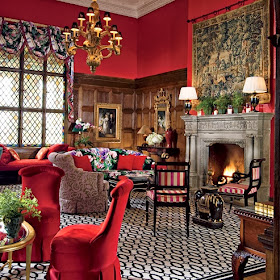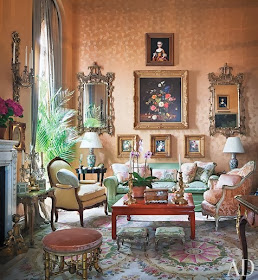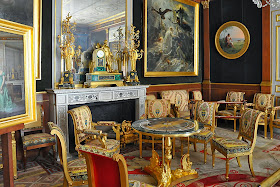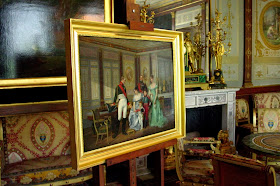For success in your home decor, be sure to incorporate pattern and texture with your color. The goal is to artfully mix patterns, colors, and styles for an effect that's just right. Many homeowners are terribly shy when it comes to the use of multiple mixed patterns in the design of their decor. However, introducing pattern to a room instantly energizes and adds interest. These could be patterns printed on wallpaper, painted on walls, in tiles, woven into fabrics, in tapestries and wallhangings, the possibilities are endless.
Have you ever wanted to bring new life to a tired room without having to start all over? The answer might be as simple as adding a new mix of pattern! Today we have such a great variety of wonderful patterns available to us that it’s fun and easy to improve any room’s personality in a matter of hours by mixing and layering lovely patterns. By changing even a few small items, you can create a big impact on a room.
I like mixing multiple patterns because of the interest it brings to a room. Some of the images I have posted below may be too layered for some tastes but you can still use them to learn from. After all you can always take away a pattern or two. Maybe just a punch of mixed, colorful, pattern in a room is all you need to breathe new life into your living space. Keep scrolling, there are mixes for everyone's taste including the tone on tone pattern mix. If you have considered using patterns and pretty prints in your decor but are afraid of your interiors looking like one big kaleidoscope, here are some useful interior design tips to help to make your decision a confident one.
Henri Samuel
Designer Henri Samuel creates a feast for the eyes in this wonderful room. Layering patterns can be challenging, but when done right, the payoff is well worth the effort. If this is too much for you practice on it by taking away elements and deciding on at least 2 other patterns you would like to continue to use against the green marbled effect background. Maybe just the rug, the red tufted ottoman and the leafy patterned chairs.
Jacque Garcia
Whether or not you have the kind of wonderful high-ceilinged spaces that predominate here, you can learn much from how the patterns are mixed.
Geoffrey Bennison
European style pattern mixes include florals, chintz, toile, chinoiserie, checks, plaid and stripes which provide lots of ideas for combining all kinds of prints in striking and unusual ways.
Ralph Lauren's country house. He uses lots of pattern against a solid background of white walls. The solid sofa also allows the patterns to take center stage. Most people find it easier and more comfortable to mix this way using the patterns on accent pieces, accessories and pillows.
Cowtan & Tout fabrics
Patterns with themes of flowers and nature accented with candy colors are romantic yet whimsical, and appeal to feminine sensibilities!
A general rule of thumb for mixing pattern in interior design is to use large patterns on large furnishings, medium on medium, and small prints on small things such as accent pieces. However, as you can see in this picture the small print is on the medium sized sofa and the large stripes on on small pillows. So basically you can throw the rule out the window. It is best if you can learn to trust your eye, It will tell you if it looks right.
A lovely mix of florals and plaid and the quilt brings the "pop". Choose a very different pattern that's half the scale or size of the first pattern. If your first pattern is a large floral, the second pattern could be a plaid or geometric shape that has some of the same colors. Then add one more, usually a small scale. Always select at least 3 patterns. In decorating think in terms of odd numbers.
The plaid window treatment with several small scale prints on the chair and sofa and some large decorative printed pillows for energy. The whole room is anchored by the rug. This is a great example of the use of color and mixed pattern.
Wall coverings are also a way to introduce pattern into a room and it can be the leading star or a supporting actor. It is important that you maintain balance when working with pattern.
Generally, there are four types of pattern, namely floral, geometric, motif and pictorial. Here you have it all. When mixing and matching pattern, always select a recurring color or theme. Avoid using more than one pattern of a similar scale; pair a large motif with a small print.
The scale of each pattern is different from the others so they don't compete with each other. There should be plenty of solid colors too, like in this room, so the mixed patterns don't overwhelm the room.
Every room needs a dominant pattern and smaller supporting patterns.
The Dorthy Draper style of bold colors and mixed patterns.
Mario Buatta
The rug is the center of attention here with a softer subtle mixing of patterns supporting it at eye level.
Denning and Fourcade
If you like English interiors, then you must learn to be comfortable with multiple layers of pattern.
Pattern mixing today is easier since companies manufacture companion fabrics. If you don't trust your own eye you can always decorate with these.
If the largest scale pattern is not very bold you may want to use stronger patterns in pillows or accent pieces. This background wallpaper has a large pattern but it doesn't overwhelm, it just sets the stage for bolder pillows.
Lot's of pattern but all in keeping with the same color palette.
Michelle Nussbaumer
Similar color ways is also another way to unify different patterns. These pillows are all different designs but the colors are all the same..Sometimes you may find a fabric that is reversible or comes in two versions of the same design - the negative and positive forms of the design. That's a very effective way to mix patterns also.
Abstract and geometric patterns mixed together bring a more contemporary feel to a room.
Pattern can also be introduced through artwork. This room has a successful mix of pattern.
Modern, chic, and layered with pattern.
A solid sofa is the ideal place to be bold with pattern! Toss on some lovely mixed patterned pillows.
I love to bring pattern in by way of furniture. I like it painted or carved .... just subtle touches of pattern throughout. There are at least 10 patterns in this room but they are subdued and well mixed so that they accent instead of overwhelm the room.
source unknown
Another lovely mixing of pattern. Tone on tone pattern is more subtle and perhaps a better choice for those of you who just aren't interested in going bold.
Another lovely mixing of pattern. Tone on tone pattern is more subtle and perhaps a better choice for those of you who just aren't interested in going bold.
You don't have to use colored patterns in a room - neutrals work very well too. There are many different patterns in this room but it has a very cohesive feeling.
With neutrals the most important thing to remember is make sure you stay with the same family whether it is cream, taupe, beige, white. They don't mix well together and your room will be a disaster.
houzz.com
Mixed pattern and texture are crucial to the neutral room's success. Without it you simply have a beige room.
It is hard to explain how to mix pattern because so much depends on the eye and there are so many combinations to choose from. Have fun with pattern and remember almost anything goes in today's interior design.I hope this post has been of some help to you.
Visit my website at www.lisafarmerdesigns.com
It is hard to explain how to mix pattern because so much depends on the eye and there are so many combinations to choose from. Have fun with pattern and remember almost anything goes in today's interior design.I hope this post has been of some help to you.
Visit my website at www.lisafarmerdesigns.com
Click here to see the previous post!
This blog post was published by
Lisa Farmer

.jpg)
.jpg)

.jpg)






.jpg)



.jpg)




.jpg)
.jpg)
.jpg)





.jpg)
.jpg)
.jpg)
.jpg)
.jpg)



.jpg)
.jpg)


.jpg)


+(1).jpg)



.jpg)
.jpg)

.jpg)


.jpg)
.jpg)
.JPG)
.jpg)






+(1).jpg)











+(1).jpg)
.jpg)

.jpg)
.jpg)
.jpg)
+(1).JPG)





.jpg)
+(1).jpg)


